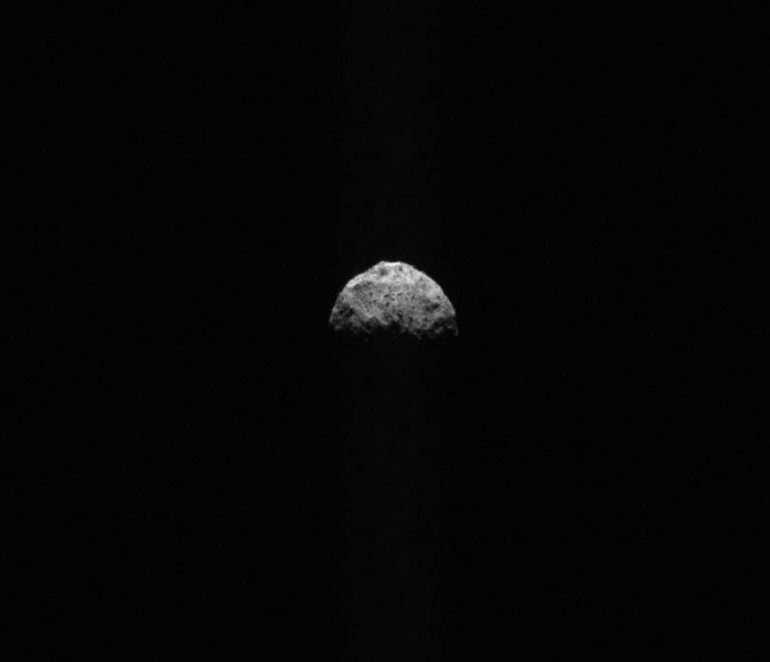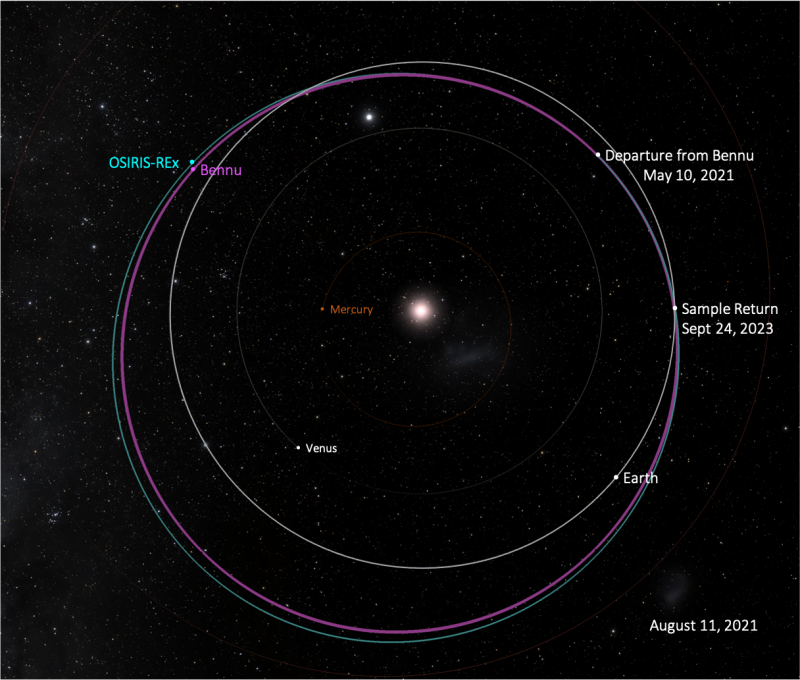New odds on asteroid Bennu
At a news conference on August 11, 2021, NASA scientists said there is a 1-in-1,750 chance that asteroid Bennu could collide with Earth between now and the year 2300. The greatest chance in the next 300 years will come on September 24, 2182. The estimates suggest a slightly greater chance than previously, but scientists say they are not worried. Planetary scientist Lindley Johnson of NASA’s Planetary Defense Coordination Office said at Wednesday’s press briefing:
I don’t think we need to do anything about Bennu.
Still, Bennu and another asteroid known as (29075) 1950 DA remain the two most hazardous asteroids to Earth, as far as scientists know at this time. NASA was concerned enough about Bennu that it sent a spacecraft to the asteroid. The OSIRIS-REx spacecraft rendezvoused with Bennu in late 2018 and touched down on the asteroid’s surface in late 2020, successfully collecting a sample.
The spacecraft learned, among other things, that Bennu is very dark, and very ancient. It’s a bit wider than the Empire State Building in New York City is tall. A NASA statement said that, along with collecting a sample from Bennu’s surface, the spacecraft provided precision data to better predict the near-Earth object’s orbit around the sun. Those predictions were published in a study, also released on August 11. The journal Icarus published the new study, Ephemeris and hazard assessment for near-Earth asteroid (101955) Bennu based on OSIRIS-REx data. The NASA statement said:
In 2135, asteroid Bennu will make a close approach with Earth. Although the near-Earth object will not pose a danger to our planet at that time, scientists must understand Bennu’s exact trajectory during that encounter in order to predict how Earth’s gravity will alter the asteroid’s path around the sun – and affect the hazard of [future] Earth impact.
Using NASA’s Deep Space Network and state-of-the-art computer models, scientists were able to significantly shrink uncertainties in Bennu’s orbit, determining its total impact probability through the year 2300 is about 1 in 1,750 (or 0.057%). The researchers were also able to identify Sept. 24, 2182, as the most significant single date in terms of a potential impact, with an impact probability of 1 in 2,700 (or about 0.037%).
Davide Farnocchia, a scientist at the NASA Jet Propulsion Laboratory in California and lead author of the paper, told the New York Times:
It’s not a significant change. I’m not any more concerned about Bennu than I was before. The impact probability remains really small.
OSIRIS-REx left Bennu on May 10, 2021. It gathered information about the asteroid’s size (it is about 1/3 of a mile, or 500 meters, wide), shape, mass, and composition, and its spin and orbital trajectory. The spacecraft will deliver its precious sample of rock and dust from the asteroid’s surface to Earth on September 24, 2023. Farnocchia commented:
The OSIRIS-REx data give us so much more precise information, we can test the limits of our models and calculate the future trajectory of Bennu to a very high degree of certainty through 2135. We’ve never modeled an asteroid’s trajectory to this precision before.

Gravitational keyholes
In recent year, scientists have sometimes spoken about close-passing asteroids in terms of a gravitational keyhole. Bennu will pass through a gravitational keyhole during its 2135 close approach. NASA said:
These keyholes are areas in space that would set Bennu on a path toward a future impact with Earth if the asteroid were to pass through them at certain times, due to the effect of Earth’s gravitational pull.
To calculate exactly where the asteroid will be during its 2135 close approach – and whether it might pass through a gravitational keyhole – Farnocchia and his team evaluated various types of small forces that may affect the asteroid as it orbits the Sun. Even the smallest force can significantly deflect its orbital path over time, causing it to pass through or completely miss a keyhole.
Among those forces, the sun’s heat plays a crucial role. As an asteroid travels around the sun, sunlight heats up its dayside. Because the asteroid spins, the heated surface will rotate away and cool down when it enters the nightside. As it cools, the surface releases infrared energy, which generates a small amount of thrust on the asteroid, a phenomenon called the Yarkovsky effect. Over short timeframes, this thrust is minuscule, but over long periods, the effect on the asteroid’s position builds up and can play a significant role in changing an asteroid’s path.
Steve Chesley, senior research scientist at JPL and study co-investigator, commented:
The Yarkovsky effect will act on all asteroids of all sizes, and while it has been measured for a small fraction of the asteroid population from afar, OSIRIS-REx gave us the first opportunity to measure it in detail as Bennu traveled around the sun. The effect on Bennu is equivalent to the weight of three grapes constantly acting on the asteroid – tiny, yes, but significant when determining Bennu’s future impact chances over the decades and centuries to come.
NASA said the team considered many other perturbing forces as well, including the gravity of the sun, the planets, their moons, and more than 300 other asteroids, the drag caused by interplanetary dust, the pressure of the solar wind, and Bennu’s particle-ejection events. NASA said:
The researchers even evaluated the force OSIRIS-REx exerted when performing its Touch-And-Go (TAG) sample collection event October 20, 2020, to see if it might have slightly altered Bennu’s orbit, ultimately confirming previous estimates that the TAG event had a negligible effect.
Rich Burns, OSIRIS-REx project manager at NASA’s Goddard Space Flight Center in Greenbelt, Maryland, explained:
The force exerted on Bennu’s surface during the TAG event were tiny even in comparison to the effects of other small forces considered. TAG did not alter Bennu’s likelihood of impacting Earth.

Tiny risk, huge gain
Although a 0.057% impact probability through the year 2300 and an impact probability of 0.037% on September 24, 2182, are low, this study highlights the crucial role that OSIRIS-REx operations played in precisely characterizing Bennu’s orbit, NASA said. Dante Lauretta, OSIRIS-REx principal investigator and professor at the University of Arizona, commented:
The orbital data from this mission helped us better appreciate Bennu’s impact chances over the next couple of centuries and our overall understanding of potentially hazardous asteroids, an incredible result. The spacecraft is now returning home, carrying a precious sample from this fascinating ancient object that will help us better understand not only the history of the solar system but also the role of sunlight in altering Bennu’s orbit since we will measure the asteroid’s thermal properties at unprecedented scales in laboratories on Earth.

Bottom line: At a press conference August 11, 2021, planetary scientists released new odds on asteroid Bennu and its potential to strike Earth. They said there is a 1-in-1,750 chance that asteroid Bennu could collide with Earth between now and the year 2300.











